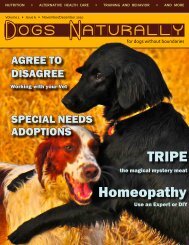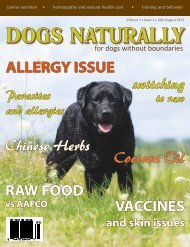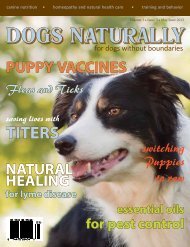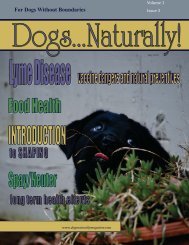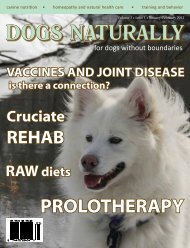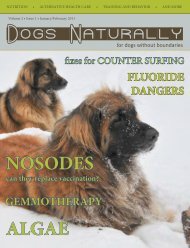For Dogs Without Boundaries - Dogs Naturally Magazine
For Dogs Without Boundaries - Dogs Naturally Magazine
For Dogs Without Boundaries - Dogs Naturally Magazine
You also want an ePaper? Increase the reach of your titles
YUMPU automatically turns print PDFs into web optimized ePapers that Google loves.
1. The disease is serious, even life threatening.<br />
2. The animal is or will be exposed to the disease.<br />
3. The vaccine for the disease is known to be effective.<br />
4. The vaccine for the disease is considered safe.<br />
Let us take Feline Leukemia virus (FeLV) disease as an<br />
example. An indoor only cat will not be exposed as this<br />
requires direct, intimate, cat-to-cat contact. Many veterinarians<br />
recommend immunizing indoor cats against<br />
this disease. I feel this is unethical. This disease does<br />
not fit criteria number three or four anyway in my experience,<br />
so vaccination is unwarranted in most if not<br />
all circumstances. Feline Infectious Peritonitis (FIP)<br />
virus disease is another disease which fits neither<br />
three or four. FIP vaccine has generally been found<br />
ineffective and has produced severe side effects.<br />
Among the side effects I have observed with both FIP<br />
and FeLV is induction of the clinical disease they were<br />
intended to prevent. In dogs, Canine Hepatitis (CH)<br />
virus is almost nonexistent (the vaccine virus to prevent<br />
CH is Adenovirus-2). Leptospirosis is extremely<br />
rare and often not the same serotype used in the vaccine<br />
7 and the bacterin for "lepto" is very prone to side<br />
effects.<br />
Coronavirus disease was never a serious threat except<br />
to dog companions' bank accounts, the same being<br />
true for Lyme disease except possibly in very small<br />
regions. Kennel cough disease is generally not serious<br />
(criteria one), and one study showed immunization to<br />
be ineffective or even counterproductive. 8 Immunization<br />
should be limited to high risk circumstances, if at<br />
all. A similar situation exists with the feline upper respiratory<br />
diseases; most are not serious except in very<br />
young kittens who contract the disease before vaccines<br />
are typically administered. Rabies is another disease<br />
for which indoor cats and well confined dogs have no<br />
exposure, so the vaccine is clinically unnecessary although<br />
required by law. Fourth, vaccines should<br />
NEVER be given to unhealthy animals. This is a practice<br />
that is gaining popularity among veterinarians for<br />
some strange reason, and it goes against the recommendations<br />
in all vaccine inserts as well as those of<br />
virtually all immunologists. This is malpractice in my<br />
opinion.<br />
A bolder option is to refuse immunizations entirely,<br />
recognizing the inherent risk in administration of even<br />
one vaccine into the body, and being willing to accept<br />
the risk of not immunizing. While risk does exist if animals<br />
are unvaccinated, it can be moderated significantly<br />
by feeding better quality foods (home prepared,<br />
including fresh, raw meats) and by limiting exposure<br />
until the animals are six to eight months of age. An unvaccinated<br />
animal will be significantly less likely to<br />
suffer from allergies and many health problems. Skin<br />
allergic reactions have been associated with vaccine<br />
administration, 9 and tremendous numbers of dogs and<br />
cats have skin allergies today. Some other diseases for<br />
which links to vaccines are known or suspected include<br />
epilepsy, thyroid disorders 10 (hyper- and hypothyroidism),<br />
chronic hepatitis, renal failure, cystitis or<br />
lower urinary tract disease (particularly in cats), autoimmune<br />
hemolytic anemia, 11 neurological diseases<br />
such as confusion and inability to be “present", asthma,<br />
and so on. In humans sudden infant death syndrome is<br />
strongly linked to DPT vaccination, 12 as are attention<br />
deficit disease/hyperactivity and autism, 13 among<br />
many others including severe brain damage.<br />
Why are vaccines worse than natural exposure Probably<br />
the major factors are the artificial means by which<br />
exposure is created with vaccines and the repetition.<br />
With few exceptions (primarily rabies and occasionally<br />
Feline Leukemia virus or Feline Immunodeficiency<br />
virus), infectious organisms are transmitted via oral<br />
and nasal exposure, and this response begins at the<br />
oral/nasal level with recognition of a foreign material<br />
or organism, followed by initial non-specific destruction<br />
and elimination of the organism at the local site of<br />
exposure as well as within the blood stream whence an<br />
organism may not even reach the interior to cause<br />
deep illness, but may be successfully repelled at the<br />
periphery. In other cases the body would have a lag<br />
time of several hours or even days to begin mounting a<br />
response before the "invader" reaches interior organs.<br />
As a consequence, deeper pathology may be minimized<br />
or even averted. This interior organ pathology may be<br />
a direct result of the organism, or it may be an indirect<br />
result, manifested through antigen-antibody complexes<br />
or other immune system components. These<br />
components may inadvertently damage body tissues<br />
as "innocent bystanders", or may directly attack or<br />
invade tissues due to recognition problems<br />
(autoimmune diseases). The latter may happen because<br />
of similarity between organism structures and<br />
host tissues; often this involves the nucleoproteins<br />
(DNA or RNA), molecules that are important for controlling<br />
activity at a cellular level.<br />
<strong>Dogs</strong>...<strong>Naturally</strong>! January/February 2010 | 18




